Information from the International Association of Pediatric Dentists for parents of children ages 6-10
Some Common Questions
- When will my child start getting permanent teeth?
- My child lost the baby teeth a few months ago and the new teeth have not grown in. Should I be worried?
- How can I prevent my child from getting cavities as he/she starts growing permanent teeth?
- When do children begin to floss their own teeth?
- Why are my child’s new front teeth more yellow than the baby teeth next to them?
- What can be done for my child who is still thumb sucking?
- Why does my child have two rows of teeth?
- Why does my child have a large space between the new front teeth?
- Do many children have missing teeth?
- Why do children need sealants?
- Does my child need a mouthguard for sports?
- If a child has bad primary teeth, will they have bad permanent teeth?
Some Answers for parents of children ages 6-10
-
When will my child ages 6-10 start getting permanent teeth?
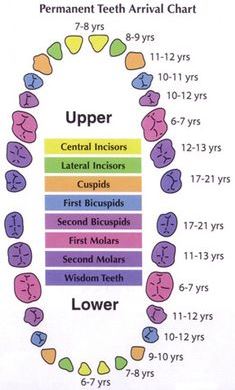 The arrival of permanent teeth occurs at 6 years +/- 6 months. With the exception of the wisdom teeth, the last of the permanent teeth come in around 12 years of age.
The arrival of permanent teeth occurs at 6 years +/- 6 months. With the exception of the wisdom teeth, the last of the permanent teeth come in around 12 years of age.
Tooth eruption can be variable. Girls tend to get teeth earlier than boys. However it is not so much the timing that is important as the sequence of tooth eruption. When individual teeth are delayed, this could indicate local problems. A good reason to see your dentist regularly is to have development supervised.
-
My child lost the baby teeth a few months ago and the new teeth have not grown in. Should I be worried?
Sometimes when the children lose a baby tooth the new tooth is right there and you can see it immediately. Sometimes it takes months for them to start coming into the mouth. This is related to many factors like the amount of space available for the tooth to grow, the position of the individual tooth, and even family traits. Ask your dentist this question as your child loses the first tooth. Your dentist or hygienist can go over the radiographs of your child to tell you what to expect, and make you aware of any potential problems.
-
How can I prevent my child from getting cavities as he/she starts growing permanent teeth?
As children start school, they also start increasing their independence with daily habits and food choices in and out of the home. To insure your child continues to have healthy teeth and body:
- Continue to supervise brushing with fluoride toothpaste twice a day. Children ages 6-10 who are supervised to brush develop less cavities than children who do it by themselves. As children’s bodies grow and so does their ability to spit, the amount of fluoride toothpaste is not as crucial. You can let them exercise some independence, but with supervision to insure the removal of plaque from all teeth. Disclosing tablets or rinses are very helpful to show them the areas where plaque is hard to reach.
- Talk to your child about good food and beverage choices when they are at school. Plain milk and water should always be mentioned as the best drink choices. Discourage the habit of drinking sweet beverages routinely (soda, chocolate milk, fruit juices or energy drinks), as they increase their chances of getting cavities and becoming overweight.
- As children grow older, encourage to minimize snacking between meals and teach children to choose fresh fruits and vegetables instead of snacks made from refined carbohydrates (like chips) or candy.
-
When do children begin to floss their own teeth?
Flossing teeth is difficult. Children acquire these abilities at different rates. Studies with 7 to 8 year olds have shown that many of the children do not have the ability to self-floss at this time. Consequently, at about 8 to 10 years of age we suggest that children can be introduced to self-flossing. Begin by learning to floss the front teeth. Then, when they can do this well, begin to floss in the back of the mouth.
Alternately, even young children ages 6-10 can use flossers with a handle to make it easier to practice alone and gives easier access for parents to help.
It is important to floss correctly. Your dental team can help you learn.
-
Why are my child’s new front teeth more yellow than the baby teeth next to them?
Newly erupted permanent teeth have large pulps and their enamel is more translucent than the very white opaque enamel of baby teeth. This makes them seem like they are more yellow in contrast. As the tooth develops more, the color will tend to look lighter and blend-in more with the surrounding teeth. As more permanent teeth grow next to each other, their color will also look more uniform and lighter. If you want your children’s teeth to look their whitest, brushing gently twice a day with fluoride toothpaste will remove the debris and stain that could make them look even more yellow, while keeping them healthy.
-
What can be done for my child between ages 6-10 who is still thumb sucking?
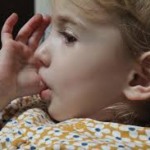
Most experts think that by 6 years of age, when the permanent teeth start to come in, is the proper age to treat the habit.
We like to see the habit discontinued because it can push the new teeth into poor alignment. Finger sucking encourages the upper teeth to protrude. It also can be associated with poor speech, social stresses and other habits. These habits are treated with psychologically based programs and/or mouth appliances. Correction of the habit is sometimes not easy. Your dentist should be able to evaluate and recommend which method is most suited for your child’s individual situation.
-
Why does my child have two rows of teeth?
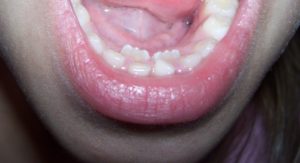 The most common site for this to occur is in the lower front tooth region. It happens in 30% of children. The appearance of two rows of teeth is due to the permanent teeth coming in behind the primary teeth. This is usually caused by a discrepancy between the size of the new teeth, and the space available for them to grow.
The most common site for this to occur is in the lower front tooth region. It happens in 30% of children. The appearance of two rows of teeth is due to the permanent teeth coming in behind the primary teeth. This is usually caused by a discrepancy between the size of the new teeth, and the space available for them to grow.
Your dentist should be consulted. An x-ray may be needed to determine how much of the root of the primary tooth remains. Sometimes the primary teeth need removal but in many cases, if the primary teeth are already loose, they fall out after a few weeks.
-
Why does my child have a large space between the new front teeth?
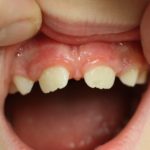
A large space sometimes is noticed when the two upper front teeth come in. This space is called a diastema. The easy answer is that this is a normal part of jaw development in children ages 6-10. As more teeth arrive, the space tends to close. When the eye teeth arrive near the teenage years, the space is usually closed. For the most part, presence of a diastema before age 12 is usually an indication that the permanent teeth will have enough room to grow straight. However, there can be other causes for space between front teeth and the area may need x-ray investigation by your dentist to rule out any potential problems.
-
Do many children have missing teeth?
About 1 in 20 people have variations in the number of teeth. Some have extra teeth and some have missing teeth. Missing teeth are more common in the permanent dentition than in the primary set of teeth. Some people only have one or two missing teeth. There may be no apparent reason for this occurrence or it may be something that other family members have as well. Some people have numerous missing teeth. This could be related to some type of systemic condition. Your dentist can help make a plan to manage the space so the children can retain proper function in spite of the missing teeth; he/she can also coordinate the treatment with the orthodontist to properly manage the space and possible replacement in the long term.
-
Why do children ages 6-10 need sealants?
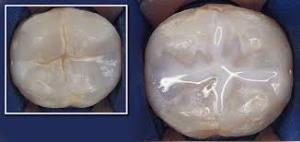 When teeth first come into the mouth they are more at risk for tooth decay. The permanent teeth that benefit the most from getting sealants are the permanent molars. The first molars arrive at about 6 years of age and often have deep grooves on the chewing surfaces. Tooth brushing is often not enough to clean these grooves properly, so over the years many of these new molars will get tooth decay. The sealant is a protective hard coating that fills-in the deep grooves in the chewing surfaces of the back teeth, so that food cannot collect in them. The smooth surface also makes the tooth easier to clean. This prevents them from decaying! Sealants have a long track of being safe, and they are the most effective way to prevent cavities in the chewing surfaces of back teeth. Sealants are usually placed on permanent teeth, but if children are at risk of developing new cavities in the chewing surfaces of primary back teeth, they can benefit from having sealants placed on their primary teeth too.
When teeth first come into the mouth they are more at risk for tooth decay. The permanent teeth that benefit the most from getting sealants are the permanent molars. The first molars arrive at about 6 years of age and often have deep grooves on the chewing surfaces. Tooth brushing is often not enough to clean these grooves properly, so over the years many of these new molars will get tooth decay. The sealant is a protective hard coating that fills-in the deep grooves in the chewing surfaces of the back teeth, so that food cannot collect in them. The smooth surface also makes the tooth easier to clean. This prevents them from decaying! Sealants have a long track of being safe, and they are the most effective way to prevent cavities in the chewing surfaces of back teeth. Sealants are usually placed on permanent teeth, but if children are at risk of developing new cavities in the chewing surfaces of primary back teeth, they can benefit from having sealants placed on their primary teeth too.
-
Does my child need a mouthguard for sports?
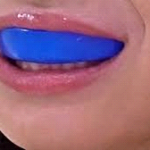
Mouthguards help lessen injuries to mouth and teeth. They are used in many sports where there is a possibility of injury.
Mouthguards are best fitted from a mold of your child’s teeth or they can be purchased commercially. The custom fitted mouthguard is a superior fit. This makes it easier for the child to talk wearing the appliance and it offers better protection. However, for a child in the 6 to 9 age bracket, teeth are constantly falling out and being replaced. It may be more practical for this age group to purchase the commercial guards. The more expensive fitted guards can be purchased when all the permanent teeth are in place. Note that mouthguards can also be made and strongly recommended for children wearing braces.
-
If a child has bad primary teeth, will they have bad permanent teeth?

This does not have to be the case. To have dental decay we need teeth, germs in the mouth and sweet foods. If germs collect in large numbers and sweet foods are eaten regularly and allowed to remain in the mouth without being brushed away, we have a recipe for tooth decay. Sadly, bad habits like eating sweet foods and drinks too often and not brushing with fluoride toothpaste can often persist for a long time and after causing cavities in primary teeth, go on to cause cavities on permanent teeth as they come into the mouth. Children who have cavities on their baby teeth have a lot more chances of having cavities on their permanent teeth. But a lifestyle change with a nutritious diet that limits sugar, proper brushing twice a day with fluoride toothpaste, and regular dental visits can change the mouth environment completely, giving the new teeth a chance to grow healthy. So, bad permanent teeth do not have to follow bad primary teeth.